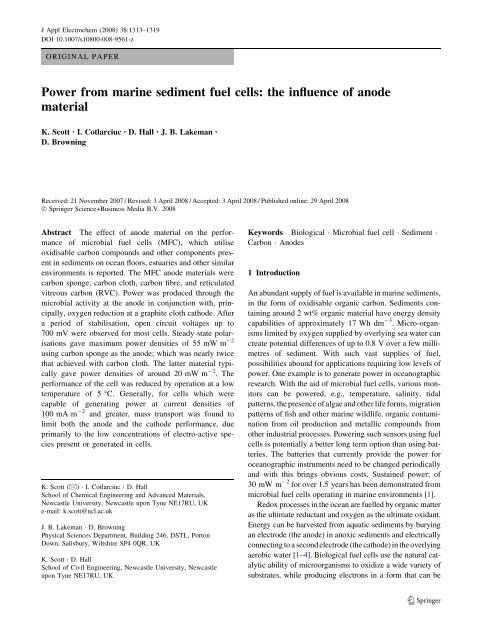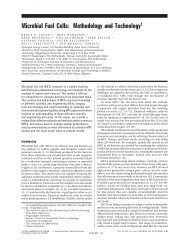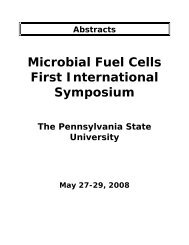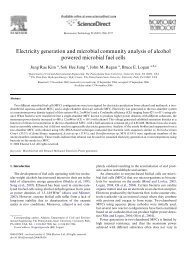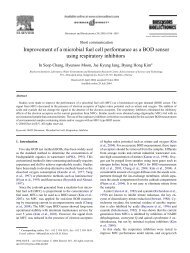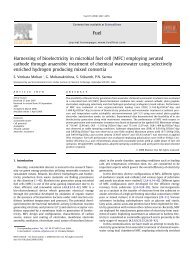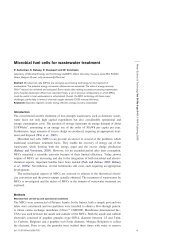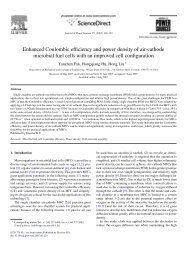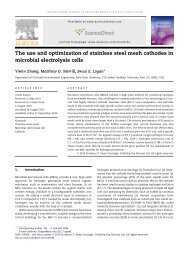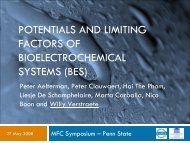Power from marine sediment fuel cells: the influence of anode material
Power from marine sediment fuel cells: the influence of anode material
Power from marine sediment fuel cells: the influence of anode material
You also want an ePaper? Increase the reach of your titles
YUMPU automatically turns print PDFs into web optimized ePapers that Google loves.
J Appl Electrochem (2008) 38:1313–1319<br />
DOI 10.1007/s10800-008-9561-z<br />
ORIGINAL PAPER<br />
<strong>Power</strong> <strong>from</strong> <strong>marine</strong> <strong>sediment</strong> <strong>fuel</strong> <strong>cells</strong>: <strong>the</strong> <strong>influence</strong> <strong>of</strong> <strong>anode</strong><br />
<strong>material</strong><br />
K. Scott Æ I. Cotlarciuc Æ D. Hall Æ J. B. Lakeman Æ<br />
D. Browning<br />
Received: 21 November 2007 / Revised: 3 April 2008 / Accepted: 3 April 2008 / Published online: 29 April 2008<br />
Ó Springer Science+Business Media B.V. 2008<br />
Abstract The effect <strong>of</strong> <strong>anode</strong> <strong>material</strong> on <strong>the</strong> performance<br />
<strong>of</strong> microbial <strong>fuel</strong> <strong>cells</strong> (MFC), which utilise<br />
oxidisable carbon compounds and o<strong>the</strong>r components present<br />
in <strong>sediment</strong>s on ocean floors, estuaries and o<strong>the</strong>r similar<br />
environments is reported. The MFC <strong>anode</strong> <strong>material</strong>s were<br />
carbon sponge, carbon cloth, carbon fibre, and reticulated<br />
vitreous carbon (RVC). <strong>Power</strong> was produced through <strong>the</strong><br />
microbial activity at <strong>the</strong> <strong>anode</strong> in conjunction with, principally,<br />
oxygen reduction at a graphite cloth cathode. After<br />
a period <strong>of</strong> stabilisation, open circuit voltages up to<br />
700 mV were observed for most <strong>cells</strong>. Steady state polarisations<br />
gave maximum power densities <strong>of</strong> 55 mW m -2<br />
using carbon sponge as <strong>the</strong> <strong>anode</strong>; which was nearly twice<br />
that achieved with carbon cloth. The latter <strong>material</strong> typically<br />
gave power densities <strong>of</strong> around 20 mW m -2 . The<br />
performance <strong>of</strong> <strong>the</strong> cell was reduced by operation at a low<br />
temperature <strong>of</strong> 5 °C. Generally, for <strong>cells</strong> which were<br />
capable <strong>of</strong> generating power at current densities <strong>of</strong><br />
100 mA m -2 and greater, mass transport was found to<br />
limit both <strong>the</strong> <strong>anode</strong> and <strong>the</strong> cathode performance, due<br />
primarily to <strong>the</strong> low concentrations <strong>of</strong> electro-active species<br />
present or generated in <strong>cells</strong>.<br />
K. Scott (&) I. Cotlarciuc D. Hall<br />
School <strong>of</strong> Chemical Engineering and Advanced Materials,<br />
Newcastle University, Newcastle upon Tyne NE17RU, UK<br />
e-mail: k.scott@ncl.ac.uk<br />
J. B. Lakeman D. Browning<br />
Physical Sciences Department, Building 246, DSTL, Porton<br />
Down, Salisbury, Wiltshire SP4 0QR, UK<br />
K. Scott D. Hall<br />
School <strong>of</strong> Civil Engineering, Newcastle University, Newcastle<br />
upon Tyne NE17RU, UK<br />
Keywords Biological Microbial <strong>fuel</strong> cell Sediment <br />
Carbon Anodes<br />
1 Introduction<br />
An abundant supply <strong>of</strong> <strong>fuel</strong> is available in <strong>marine</strong> <strong>sediment</strong>s,<br />
in <strong>the</strong> form <strong>of</strong> oxidisable organic carbon. Sediments containing<br />
around 2 wt% organic <strong>material</strong> have energy density<br />
capabilities <strong>of</strong> approximately 17 Wh dm -3 . Micro-organisms<br />
limited by oxygen supplied by overlying sea water can<br />
create potential differences <strong>of</strong> up to 0.8 V over a few millimetres<br />
<strong>of</strong> <strong>sediment</strong>. With such vast supplies <strong>of</strong> <strong>fuel</strong>,<br />
possibilities abound for applications requiring low levels <strong>of</strong><br />
power. One example is to generate power in oceanographic<br />
research. With <strong>the</strong> aid <strong>of</strong> microbial <strong>fuel</strong> <strong>cells</strong>, various monitors<br />
can be powered, e.g., temperature, salinity, tidal<br />
patterns, <strong>the</strong> presence <strong>of</strong> algae and o<strong>the</strong>r life forms, migration<br />
patterns <strong>of</strong> fish and o<strong>the</strong>r <strong>marine</strong> wildlife, organic contamination<br />
<strong>from</strong> oil production and metallic compounds <strong>from</strong><br />
o<strong>the</strong>r industrial processes. <strong>Power</strong>ing such sensors using <strong>fuel</strong><br />
<strong>cells</strong> is potentially a better long term option than using batteries.<br />
The batteries that currently provide <strong>the</strong> power for<br />
oceanographic instruments need to be changed periodically<br />
and with this brings obvious costs. Sustained power; <strong>of</strong><br />
30 mW m -2 for over 1.5 years has been demonstrated <strong>from</strong><br />
microbial <strong>fuel</strong> <strong>cells</strong> operating in <strong>marine</strong> environments [1].<br />
Redox processes in <strong>the</strong> ocean are <strong>fuel</strong>led by organic matter<br />
as <strong>the</strong> ultimate reductant and oxygen as <strong>the</strong> ultimate oxidant.<br />
Energy can be harvested <strong>from</strong> aquatic <strong>sediment</strong>s by burying<br />
an electrode (<strong>the</strong> <strong>anode</strong>) in anoxic <strong>sediment</strong>s and electrically<br />
connecting to a second electrode (<strong>the</strong> cathode) in <strong>the</strong> overlying<br />
aerobic water [1–4]. Biological <strong>fuel</strong> <strong>cells</strong> use <strong>the</strong> natural catalytic<br />
ability <strong>of</strong> microorganisms to oxidize a wide variety <strong>of</strong><br />
substrates, while producing electrons in a form that can be<br />
123
1314 J Appl Electrochem (2008) 38:1313–1319<br />
harvested at an electrode. For example, <strong>fuel</strong> <strong>cells</strong> utilising<br />
sulphate-reducing bacteria have been constructed, with <strong>the</strong><br />
microbially produced hydrogen sulfide serving to shuttle<br />
electrons to <strong>the</strong> electrode surface [5, 6]. In addition, Fe(III)-<br />
reducing microorganisms such as Shewanella putrefaciens<br />
[7, 8], Clostridium [9], Aeromonas hydrophila [10], Rhod<strong>of</strong>erax<br />
ferrireducens [11], Desulfobulbus propionicus [12],<br />
and several species <strong>of</strong> Geobacteraceae [1, 13] have been<br />
shown to directly transfer electrons <strong>from</strong> <strong>the</strong> oxidation <strong>of</strong><br />
organic compounds to <strong>the</strong> surface <strong>of</strong> an electrode without <strong>the</strong><br />
need for an external mediator.<br />
In <strong>sediment</strong> <strong>fuel</strong> <strong>cells</strong>, natural populations <strong>of</strong> microorganisms<br />
in <strong>the</strong> anoxic <strong>sediment</strong>s are responsible for electron<br />
transfer to <strong>the</strong> current-harvesting <strong>anode</strong>. Previous cultureindependent<br />
studies and studies <strong>of</strong> organisms cultivated <strong>from</strong><br />
<strong>fuel</strong> cell <strong>anode</strong>s have indicated that a specific group <strong>of</strong><br />
Fe(III)-reducing microorganisms, <strong>the</strong> Geobacteraceae, is<br />
primarily responsible for electricity production in some<br />
<strong>sediment</strong> <strong>fuel</strong> <strong>cells</strong> [1, 2, 4]. Fur<strong>the</strong>r analysis <strong>of</strong> pure cultures<br />
<strong>of</strong> Geobacteraceae has shown that <strong>the</strong>se organisms can<br />
conserve energy to support growth by oxidizing organic<br />
compounds to carbon dioxide, with an electrode serving as<br />
<strong>the</strong> sole electron acceptor [1, 2]. Therefore, a likely explanation<br />
for <strong>the</strong> functioning <strong>of</strong> <strong>sediment</strong> <strong>fuel</strong> <strong>cells</strong> is that<br />
microorganisms in <strong>the</strong> <strong>sediment</strong>s convert <strong>the</strong> complex <strong>sediment</strong><br />
organic matter to fermentation products, most notably<br />
acetate, and that Geobacteraceae colonizing <strong>the</strong> <strong>anode</strong> oxidize<br />
<strong>the</strong>se fermentation products to carbon dioxide, with<br />
transfer <strong>of</strong> electrons to <strong>the</strong> current-harvesting electrode [1].<br />
These electrons <strong>the</strong>n flow to <strong>the</strong> cathode in <strong>the</strong> overlying<br />
aerobic water, where <strong>the</strong>y react with oxygen [3].<br />
A reaction mechanism in <strong>the</strong> <strong>marine</strong> <strong>sediment</strong> <strong>fuel</strong> cell<br />
has been proposed in which a series <strong>of</strong> microbial reductions<br />
take place progressively in <strong>the</strong> surface <strong>sediment</strong> layer,<br />
forming water <strong>from</strong> oxygen, and Mn 2+ ,Fe 2+ ,S 2- <strong>from</strong><br />
MnO 2 ,Fe 2 O 3 and SO 2- 4 respectively [14]. These reactions<br />
provide <strong>the</strong> open circuit potential <strong>of</strong> <strong>the</strong> cell and promote<br />
oxidation <strong>of</strong> <strong>sediment</strong> organic matter, (CH 2 O) 6 . Reactions<br />
that occur at <strong>the</strong> <strong>anode</strong> include oxidation <strong>of</strong> sulphide to<br />
sulphur, and oxidation <strong>of</strong> acetate, to CO 2 , and sulphur, to<br />
SO 2- 4 , (and potentially Fe 2+ to Fe 2 O 3 ) by micro-organisms<br />
colonising <strong>the</strong> <strong>anode</strong> [1, 2, 3]. The products <strong>of</strong> <strong>the</strong>se oxidations<br />
can again be microbially reduced by bacteria. At<br />
<strong>the</strong> cathode, dissolved oxygen in <strong>the</strong> seawater is reduced.<br />
The net reaction is oxidation <strong>of</strong> organic matter by dissolved<br />
oxygen catalyzed by <strong>sediment</strong>-dwelling anaerobes<br />
and mediated by <strong>the</strong> intermediate oxidants reduced in<br />
anaerobic respiratory reactions, e.g.:<br />
ðCH 2 OÞ 6<br />
þ 6O 2 ! 6CO 2 þ 6H 2 O<br />
ð1Þ<br />
The consequent depletion <strong>of</strong> oxygen in <strong>the</strong> <strong>sediment</strong> provides<br />
enough separation between oxygen and organic<br />
matter to provide an external circuit for electron transfer.<br />
In order to rationally optimise <strong>the</strong> harvesting <strong>of</strong> electricity<br />
<strong>from</strong> aquatic <strong>sediment</strong>s, it is necessary to understand<br />
<strong>the</strong> mechanisms <strong>of</strong> microbe-electrode electron transfer.<br />
Ideally, this phenomenon should be studied in microorganisms<br />
known to colonise energy-harvesting electrodes in<br />
<strong>sediment</strong>s. Holmes et al. [12] reported two strains isolated<br />
<strong>from</strong> <strong>the</strong> surfaces <strong>of</strong> electricity-harvesting electrodes<br />
incubated in <strong>marine</strong> <strong>sediment</strong>s. Both isolates represent a<br />
novel genus in <strong>the</strong> Geobacteraceae with <strong>the</strong> capacity to<br />
grow at temperatures (4 °C) lower than those previously<br />
reported for microorganisms in this family [15]. These<br />
organisms can also oxidise a variety <strong>of</strong> electron donors,<br />
with electrodes and Fe(III) serving as <strong>the</strong> terminal electron<br />
acceptors. This was <strong>the</strong> first report <strong>of</strong> microorganisms<br />
isolated <strong>from</strong> electrode surfaces that can effectively oxidise<br />
organic compounds to carbon dioxide with an electrode<br />
serving as <strong>the</strong> electron acceptor.<br />
In previous studies <strong>of</strong> <strong>sediment</strong> <strong>fuel</strong> <strong>cells</strong> Tender et al.<br />
[4] (2002) have created a simple microbial <strong>fuel</strong> cell using<br />
different <strong>sediment</strong>s on <strong>the</strong> sea floor, based on two carbon<br />
electrodes placed in two different environments: one in <strong>the</strong><br />
anoxic <strong>sediment</strong>s and <strong>the</strong> o<strong>the</strong>r in <strong>the</strong> seawater immediately<br />
above <strong>the</strong> <strong>sediment</strong>. The peak power density <strong>of</strong> <strong>the</strong> <strong>sediment</strong><br />
<strong>fuel</strong> cell was around 30 mW m -2 , at a current density<br />
<strong>of</strong> 75 mA m -2 and cell voltage <strong>of</strong> 400 mV. Recent work<br />
[14] has shown that by using modified <strong>anode</strong>s incorporating<br />
anthraquinone, quinine and manganese and iron oxide<br />
species an increase in power density, up to approximately<br />
100 mW m -2 can be achieved in a <strong>marine</strong> <strong>sediment</strong> cell.<br />
However this power was not maintained over extended<br />
periods and declined gradually with time to levels obtained<br />
with unmodified <strong>anode</strong>s.<br />
Several groups have investigated <strong>anode</strong> <strong>material</strong>s in<br />
microbial <strong>fuel</strong>s to try to increase <strong>the</strong> power output per unit<br />
volume <strong>of</strong> reactor. Logan et al. [15] investigated graphite<br />
brush <strong>anode</strong>s, consisting <strong>of</strong> graphite fibres wound around<br />
metal core. Using a simulated wastewater MFCs gave up to<br />
1430 mW m -2 with brush electrodes, compared with<br />
600 mW m -2 with a plain carbon paper electrode.<br />
A carbon nanotube (CNT)/polyaniline (PANI) composite<br />
has been evaluated as <strong>anode</strong> <strong>material</strong> for high-power<br />
microbial <strong>fuel</strong> <strong>cells</strong> [16]. The maximum power density<br />
obtained was 42 mW m -2 with Escherichia coli as <strong>the</strong><br />
microbial catalyst, which was significantly greater than that<br />
achieved with polyaniline alone.<br />
Ammonia gas treatment <strong>of</strong> a carbon cloth <strong>anode</strong> has<br />
been used to increase <strong>the</strong> surface charge <strong>of</strong> <strong>the</strong> electrode<br />
and improved MFC performance [17]. <strong>Power</strong> increased to<br />
nearly 2000 mW m -2 using a phosphate buffer with <strong>the</strong><br />
ammonia-treated electrode.<br />
The purpose <strong>of</strong> this study was to investigate <strong>the</strong> <strong>influence</strong><br />
<strong>of</strong> different un-modified electrode <strong>material</strong> on <strong>the</strong><br />
performance <strong>of</strong> <strong>marine</strong> <strong>sediment</strong> microbial <strong>fuel</strong> <strong>cells</strong><br />
123
J Appl Electrochem (2008) 38:1313–1319 1315<br />
producing low levels <strong>of</strong> power. The <strong>material</strong>s used were<br />
restricted to a selection <strong>of</strong> carbon <strong>material</strong>s with relatively<br />
high surface areas and which were not chemically modified;<br />
in an attempt to maintain long term operation.<br />
2 Experimental<br />
2.1 Microbial <strong>fuel</strong> cell<br />
Figure 1 shows a schematic <strong>of</strong> <strong>the</strong> MFC, which consisted<br />
<strong>of</strong> an inert cylindrical container, 16 cm in diameter and<br />
16 cm high. The <strong>anode</strong> was 11 cm in diameter, and was<br />
buried 3 cm below and parallel to <strong>the</strong> surface <strong>of</strong> <strong>the</strong> <strong>sediment</strong>.<br />
The cathode, 15 cm in diameter, was positioned in<br />
<strong>the</strong> seawater, 2–3 cm above and parallel to <strong>the</strong> <strong>sediment</strong><br />
surface. The seawater layer above <strong>the</strong> cathode was 5 cm in<br />
depth. No separator was used in <strong>the</strong> cell. Air supply to <strong>the</strong><br />
cathode was thus by natural diffusion <strong>from</strong> <strong>the</strong> surface <strong>of</strong><br />
<strong>the</strong> seawater unless o<strong>the</strong>rwise stated.<br />
The <strong>anode</strong> and cathode were supported by plastic rings<br />
to maintain <strong>the</strong>ir horizontal positions. The <strong>fuel</strong> <strong>cells</strong> were<br />
maintained at room temperature except when <strong>the</strong> effect <strong>of</strong><br />
temperature was investigated. Cells using different <strong>anode</strong>s<br />
were tested, in duplicate and simultaneously, using <strong>the</strong><br />
same sources <strong>of</strong> <strong>sediment</strong> and seawater, over <strong>the</strong> period <strong>of</strong><br />
<strong>the</strong> study, which for some <strong>cells</strong> was 9 months.<br />
Silver chloride references electrodes were connected to<br />
<strong>the</strong> <strong>cells</strong>, via luggin capillary probes, to measure electrode<br />
potentials. Current densities quoted in this paper are based<br />
on <strong>the</strong> <strong>anode</strong> cross sectional area.<br />
The <strong>marine</strong> <strong>sediment</strong> and seawater were collected <strong>from</strong><br />
<strong>the</strong> North Sea, <strong>of</strong>f <strong>the</strong> north-east coast <strong>of</strong> England<br />
(55°01 0 08 00 N, 1°25 0 11 00 W) at a depth <strong>of</strong> 62 m. The<br />
<strong>material</strong>s were transported under reduced temperature to<br />
restrict microbial growth, to nearby laboratory facilities<br />
As part <strong>of</strong> <strong>the</strong> test protocol, <strong>the</strong> <strong>cells</strong> were initially left to<br />
equilibrate, while monitoring <strong>the</strong> open circuit voltage<br />
(OCV). When <strong>the</strong> OCV stabilised, an external circuit was<br />
established, with electrodes connected through a variable<br />
resistor load, using ei<strong>the</strong>r a DC power supply or a variable<br />
resistor. The variable resistor was used to generate cell<br />
current density and voltage polarization data. Current<br />
generated across <strong>the</strong> cell, <strong>of</strong> <strong>the</strong> order <strong>of</strong> microamps, was<br />
measured using a multimeter, while continually monitoring<br />
<strong>the</strong> voltage via a second multimeter. O<strong>the</strong>r parameters<br />
monitored were, electrode potentials, pH, and dissolved<br />
oxygen (YSI 550A dissolved oxygen meter) in <strong>the</strong> water<br />
and in <strong>the</strong> <strong>sediment</strong>.<br />
2.1.1 Electrodes<br />
Anodes used in this study were all carbon and were<br />
selected because <strong>of</strong> <strong>the</strong>ir different characteristics (porosity,<br />
morphology, carbon type). The <strong>material</strong>s used were carbon<br />
cloth (Avcarb 1209 HC, Ballard), carbon paper (Toray<br />
Carbon Paper TGP60 0WP), carbon sponge, graphite<br />
(5 mm thick disk) and reticulated vitreous carbon (RVC).<br />
The RVC <strong>anode</strong> was 1.2 cm thick, 100 ppi (nominal pores<br />
per linear inch) grade. RVC is a porous, rigid <strong>material</strong> with<br />
an open structure and good electrical conductivity. Electrodes<br />
were pre-treated before use, by washing in acetone<br />
for 15 min, followed by boiling in 1.0 mol dm -3 (M) HCl<br />
for 15 min and <strong>the</strong>n rinsing in de-ionised water.<br />
The cathode used in all <strong>cells</strong> was carbon cloth. Silver<br />
chloride references electrodes connected to <strong>the</strong> cathodes<br />
using luggin capillary probes were used to measure electrode<br />
potentials.<br />
H 2 O<br />
O 2<br />
Cathode<br />
Ref.<br />
Electrode<br />
3 Results and discussion<br />
3.1 Performance <strong>of</strong> <strong>the</strong> <strong>sediment</strong> <strong>fuel</strong> cell<br />
Seawater<br />
Sediment<br />
H +<br />
Anode<br />
Anode<br />
x red x ox Microbes<br />
CO 2<br />
(CH C2 H4O<br />
2 O)<br />
x<br />
Load<br />
Voltmete<br />
y<br />
Ammeter<br />
Fig. 1 Schematic representation <strong>of</strong> <strong>the</strong> <strong>sediment</strong> microbial <strong>fuel</strong> cell<br />
e -<br />
At <strong>the</strong> beginning <strong>of</strong> <strong>the</strong> tests, <strong>the</strong> <strong>fuel</strong> <strong>cells</strong> were left to run<br />
at open circuit to allow bacterial colonisation <strong>of</strong> <strong>the</strong> <strong>anode</strong><br />
and cathode. The voltage <strong>of</strong> each MFC was monitored<br />
daily, until it reached equilibrium, which suggested that <strong>the</strong><br />
<strong>anode</strong> had been colonized by a ‘‘stable’’ bacterial community.<br />
The MFCs needed several weeks to equilibrate<br />
until <strong>the</strong> <strong>anode</strong>s were colonised by <strong>the</strong> bacterial population<br />
<strong>from</strong> <strong>the</strong> <strong>marine</strong> <strong>sediment</strong>. The equilibration period <strong>of</strong> <strong>the</strong><br />
<strong>cells</strong>, i.e. <strong>the</strong> time to reach a relatively stable potential,<br />
varied with <strong>the</strong> electrode <strong>material</strong>s used; this fact can be<br />
attributed to <strong>the</strong> different morphologies, structure and<br />
surface characteristics <strong>of</strong> <strong>the</strong> electrode <strong>material</strong>s and<br />
potential ‘‘biocompatibility’’ with <strong>the</strong> bacterial populations<br />
123
1316 J Appl Electrochem (2008) 38:1313–1319<br />
Ecell / mV<br />
Current density / mA m -2<br />
800<br />
30<br />
1<br />
700<br />
2 25<br />
600<br />
20<br />
500<br />
400<br />
15<br />
300<br />
10<br />
200<br />
5<br />
100<br />
0<br />
0<br />
0 20 40 60 80 100 120 140<br />
Fig. 2 Cell voltage and power density curves <strong>of</strong> <strong>the</strong> <strong>sediment</strong> <strong>fuel</strong><br />
cell with carbon cloth <strong>anode</strong>s. Two sets <strong>of</strong> data are for polarisation in<br />
successive weeks <strong>of</strong> <strong>the</strong> study. h: first polarisation; 9: second<br />
polarisation<br />
<strong>Power</strong> density / mW m -2<br />
Potential vs. Ag/AgCl / mV<br />
400<br />
300<br />
200<br />
100<br />
0<br />
0 20 40 60 80 100 120 140<br />
-100<br />
-200<br />
-300<br />
-400<br />
1<br />
2<br />
Current density / mA m -2<br />
Fig. 3 Anode and cathode polarisations for cell with a carbon cloth<br />
<strong>anode</strong>. h: first polarisation; 9: second polarisation. Upper curve:<br />
cathode polarisation. Lower curve: <strong>anode</strong> polarisation<br />
in <strong>the</strong> <strong>sediment</strong> and seawater. The OCPs gradually rose<br />
over <strong>the</strong> initial days and weeks <strong>of</strong> operation. Fluctuations<br />
in voltage arose, presumably because cell temperatures<br />
were not controlled, but varied according to <strong>the</strong> night and<br />
day time temperature <strong>of</strong> <strong>the</strong> laboratory and <strong>the</strong> fact that <strong>the</strong><br />
cell relied on natural diffusion <strong>of</strong> oxygen <strong>from</strong> <strong>the</strong> water<br />
surface.<br />
For <strong>the</strong> <strong>cells</strong> with carbon cloth electrodes, open circuit<br />
potentials were 650–700 mV (Fig. 2). The peak power<br />
densities were 20–27 mW m -2 , at cell voltages around<br />
350 mV, and peak current densities <strong>of</strong> 60 to 90 mA m -2<br />
respectively (Fig. 2). The data reflect <strong>the</strong> range <strong>of</strong> performance<br />
that was obtained <strong>from</strong> any single <strong>sediment</strong> cell<br />
tested over a period <strong>of</strong> months. The power densities are<br />
similar to those obtained by Tender et al. [4], i.e.<br />
17–30 mW m -2 using graphite electrodes.<br />
The dissolved oxygen (DO) concentration in <strong>the</strong> sea<br />
water, at 100% saturation with air, was measured at 9.2 mg<br />
dm -3 . The DO levels in both <strong>sediment</strong> and water fell<br />
gradually in <strong>the</strong> first 3–5 days and <strong>the</strong>n rose to almost<br />
constant values <strong>of</strong> 83% and 56% <strong>of</strong> saturation for water and<br />
<strong>sediment</strong> respectively. Although <strong>the</strong>se measurements were<br />
made away <strong>from</strong> <strong>the</strong> electrodes <strong>the</strong>y do indicate that <strong>the</strong><br />
MFCs were operating under partially aerobic conditions.<br />
Variations in pH were small, typically rising <strong>from</strong> around<br />
7.6 to 8.0 over <strong>the</strong> duration <strong>of</strong> <strong>the</strong> tests.<br />
Figure 3 shows <strong>the</strong> variation in <strong>anode</strong> and cathode<br />
potentials with current density for <strong>cells</strong> with carbon cloth<br />
electrodes measured at two separate times (three days<br />
apart). The <strong>anode</strong> polarisations were approximately <strong>the</strong><br />
same, although <strong>the</strong> cathode polarisations were somewhat<br />
different; <strong>the</strong> second polarisation started at a lower OCP <strong>of</strong><br />
660 mV. The fall in potential for <strong>the</strong> second polarisation<br />
was greater than that for <strong>the</strong> first and <strong>the</strong> difference<br />
between <strong>the</strong> potentials, at a fixed current density, increased<br />
as <strong>the</strong> current density increased. This difference in<br />
potential is essentially mapped in <strong>the</strong> cell voltage characteristics<br />
shown in Fig. 2.<br />
One cell with a carbon cloth <strong>anode</strong> was operated at<br />
5.0 °C; a temperature close to that experienced in <strong>the</strong><br />
<strong>marine</strong> environment. The open circuit potential started at<br />
500 mV which was lower than that obtained at room<br />
temperature. After two polarisations <strong>the</strong> peak power density<br />
was 15.0 mW m -2 ; smaller than that achieved at room<br />
temperature (Fig. 2), although clearly showing that reasonable<br />
power can be obtained at lower temperatures.<br />
The <strong>anode</strong> and cathode polarisations <strong>of</strong> <strong>the</strong> MFC operated<br />
at 5 °C were also measured. At low overpotentials<br />
cathode polarisation characteristics were linear. On<br />
increasing load, <strong>the</strong> current density rose approximately<br />
exponentially with overpotential, until mass transport<br />
limitations appeared [18]. Measured dissolved oxygen<br />
concentrations were typically 7.5 mg dm -3 , i.e. 2.5 mmol<br />
dm -3 (mM) [19]. At this concentration mass transport<br />
limiting current densities, j l , for oxygen reduction are<br />
approximately<br />
j l ¼ nFk l C O2 ¼ 10 9 k l mA m 2 ð2Þ<br />
where C O2 is <strong>the</strong> dissolved oxygen concentration, F is<br />
Faradays constant, n is <strong>the</strong> number <strong>of</strong> electrons in <strong>the</strong><br />
reduction <strong>of</strong> oxygen (4) and k l is <strong>the</strong> mass transport coefficient<br />
(m s -1 ) for oxygen transport to <strong>the</strong> electrode in an<br />
essentially stationary fluid.<br />
With a mass transport coefficient, for a horizontal<br />
electrode in a stationary fluid, <strong>of</strong> <strong>the</strong> order <strong>of</strong> 10 -7 (m s -1 )<br />
[20], <strong>the</strong> limiting current density would be around<br />
100 mA m -2 . This value is in agreement with apparent<br />
limiting current behaviour observed experimentally.<br />
The extent <strong>of</strong> cathode polarisation (change in potential)<br />
was greater than that <strong>of</strong> <strong>the</strong> <strong>anode</strong> polarisation, e.g. 80 mV cf.<br />
40 mV at 40 mA m -2 . Comparing data for <strong>the</strong> two operating<br />
temperatures, <strong>the</strong> cathode had a significant <strong>influence</strong> on cell<br />
123
J Appl Electrochem (2008) 38:1313–1319 1317<br />
behaviour, with greater polarisation at 5 °C. This would<br />
indicate that <strong>the</strong> potential impact <strong>of</strong> slower reaction kinetics<br />
at <strong>the</strong> lower temperature was only partially counteracted by a<br />
greater oxygen concentration at <strong>the</strong> lower temperature.<br />
Overall <strong>the</strong> <strong>anode</strong> was not <strong>the</strong> limiting factor on cell performance<br />
and <strong>the</strong> microbial community functioned<br />
effectively at <strong>the</strong> lower temperature.<br />
The <strong>anode</strong> polarisation characteristics were somewhat<br />
similar to that <strong>of</strong> <strong>the</strong> cathode although <strong>the</strong> extent <strong>of</strong><br />
polarisation was lower. However, it is not possible to say<br />
that <strong>the</strong> increased <strong>anode</strong> overpotential, at higher current<br />
densities, was due to mass transport limitations or to<br />
change in reactions and mechanisms for microbial based<br />
reaction. Many factors would be influencing <strong>the</strong> <strong>anode</strong><br />
behaviour including direct and indirect electron transfer at<br />
<strong>the</strong> <strong>anode</strong>, metabolic kinetics, mass transfer <strong>of</strong> mediators<br />
and mss transfer inside <strong>the</strong>n bi<strong>of</strong>ilm.<br />
3.2 Comparison <strong>of</strong> <strong>anode</strong> <strong>material</strong>s<br />
a<br />
Potential vs. Ag/AgCl / mV<br />
b<br />
Potential vs. Ag/AgCl / mV<br />
500<br />
375<br />
250<br />
125<br />
0<br />
-125<br />
-250<br />
400<br />
300<br />
200<br />
100<br />
0<br />
-100<br />
-200<br />
-300<br />
0 50 100 150 200 250<br />
Current density / mA m -2<br />
0 5 10 15 20 25<br />
Average cell potential and power density vs. current density<br />
data; for <strong>cells</strong> using carbon sponge, carbon fibre and<br />
RVC <strong>anode</strong>s, was taken over a period <strong>of</strong> 18 days. The<br />
carbon sponge <strong>anode</strong> gave power densities between 51 to<br />
54 mW m -2 at cell voltages <strong>of</strong> 300 mV and current densities<br />
<strong>of</strong> around 170 mA m -2 . The carbon fibre <strong>anode</strong> gave<br />
a peak power density <strong>of</strong> 4.5 mW m -2 and <strong>the</strong> RVC <strong>anode</strong><br />
gave a low, peak power density <strong>of</strong> 0.18 mW m -2 at a peak<br />
current density <strong>of</strong> 1.0 mA m -2 . The poor cell performance<br />
with <strong>the</strong> RVC <strong>anode</strong> was due mainly to <strong>the</strong> relatively large<br />
<strong>anode</strong> overpotential, e.g. 150 mV at a current density <strong>of</strong><br />
1.0 mA cm -2 .<br />
Figure 4 shows <strong>the</strong> <strong>anode</strong> and cathode polarisations <strong>of</strong><br />
<strong>the</strong> carbon sponge, carbon fibre and RVC based <strong>cells</strong>;<br />
obtained during <strong>the</strong> cell polarisations. The cathode polarisations<br />
were similar for each cell; due to <strong>the</strong> fact that <strong>the</strong>y<br />
all had a carbon cloth cathode. The <strong>anode</strong> clearly had a<br />
more significant <strong>influence</strong> on cell performance than <strong>the</strong><br />
cathode. For example, at an <strong>anode</strong> overpotential <strong>of</strong> 100 mV<br />
(measured <strong>from</strong> <strong>the</strong> potential at zero current), <strong>the</strong> current<br />
density with carbon sponge was around 100 mA m -2 ,<br />
compared with only 50 (see Fig. 3), 5 and 0.8 mA m -2 for<br />
carbon cloth, carbon fibre and RVC respectively.<br />
Although microbial electrochemical kinetics are complex,<br />
<strong>the</strong> polarisation behaviour <strong>of</strong> <strong>the</strong> <strong>anode</strong>s (particularly<br />
carbon fibre and RVC) exhibited characteristics somewhat<br />
typical <strong>of</strong> simple electrode reaction. At low overpotentials<br />
<strong>the</strong> current density increased almost linearly with an<br />
increase in potential. At higher overpotentials, current<br />
density rose more rapidly; partly as a result <strong>of</strong> <strong>the</strong> characteristic<br />
rise in current density with overpotential for<br />
electrochemical reactions; although <strong>the</strong> variation in current<br />
density was undoubtedly <strong>influence</strong>d by o<strong>the</strong>r factors such<br />
c<br />
Potential vs. Ag/AgCl / mV<br />
-400<br />
400 0 0.5<br />
300<br />
200<br />
100<br />
0<br />
Current density / mA m -2<br />
.<br />
Current density / mA m -2<br />
1 1.5<br />
Fig. 4 Anode and cathode polarisation curves for <strong>cells</strong> with different<br />
carbon <strong>anode</strong>s. Room temperature. Carbon cloth cathode. (a) carbon<br />
sponge, (b) carbon fibre (c) RVC. Upper curve (e): cathode<br />
polarisation. Lower curve (h): <strong>anode</strong> polarisation<br />
as mass transport <strong>of</strong> substrate, mediators etc.. Anode<br />
potentials were not IR corrected and were determined<br />
indirectly <strong>from</strong> <strong>the</strong> difference in cell potential and cathode<br />
potential.<br />
Previous researchers have characterised <strong>anode</strong> polarisation<br />
using Tafel plots <strong>of</strong> <strong>anode</strong> overpotential, in <strong>the</strong> range<br />
60–100 mV [14]. In this study [14], using linear sweep<br />
voltammetry (at 1.0 mV s -1 ) with graphite and ‘‘catalysed’’<br />
or doped graphite electrodes, <strong>the</strong> relative activity <strong>of</strong><br />
<strong>the</strong> <strong>anode</strong>s was compared by obtaining apparent exchange<br />
current densities <strong>from</strong> <strong>the</strong> intercepts <strong>of</strong> log (j) vs. overpotential<br />
plots (at zero overpotential measured against <strong>the</strong><br />
open circuit potential). The slopes <strong>of</strong> <strong>the</strong> Tafel plots were<br />
typically 250 mV per decade [14].<br />
.<br />
123
1318 J Appl Electrochem (2008) 38:1313–1319<br />
In <strong>the</strong> case <strong>of</strong> <strong>the</strong> data <strong>from</strong> our study, which were<br />
obtained during cell voltage measurements under variable<br />
load, an approximate exponential rise in current density<br />
with overpotential can be seen (Fig. 4), except for carbon<br />
sponge. In <strong>the</strong> case <strong>of</strong> carbon sponge <strong>the</strong> variation <strong>of</strong> current<br />
density with overpotential was probably <strong>influence</strong>d by<br />
internal resistance (IR) voltage loss and <strong>the</strong> onset <strong>of</strong> some<br />
mass transport limitation, at <strong>the</strong> higher current densities<br />
experienced with this <strong>anode</strong>. For carbon sponge, <strong>the</strong><br />
change in overpotential (Tafel slope) in <strong>the</strong> lower overpotential<br />
range, <strong>of</strong> 60–100 mV, was approximately<br />
100 mV per decade (Fig. 4a). This would suggest that <strong>the</strong><br />
carbon sponge <strong>anode</strong> had more favourable electrochemical<br />
characteristics compared to graphite; although <strong>the</strong> latter<br />
<strong>material</strong> used by Lowy et al. [14] was not porous.<br />
To compare <strong>the</strong> relative activity <strong>of</strong> <strong>the</strong> <strong>anode</strong>s in this<br />
work <strong>the</strong> electrochemical behaviour was quantified by<br />
using <strong>the</strong> low overpotential range (\40 mV), linear<br />
approximation <strong>of</strong> <strong>the</strong> Butler Volmer equation<br />
j ¼ 2aj o CanFg=RT ¼ 2aj o Cg=b<br />
ð3Þ<br />
where, j o , is <strong>the</strong> exchange current density, a, is <strong>the</strong> transfer<br />
coefficient, a, is <strong>the</strong> active area per unit cross sectional<br />
area <strong>of</strong> <strong>the</strong> electrode and depends on <strong>the</strong> particular<br />
<strong>material</strong> used. C is <strong>the</strong> concentration <strong>of</strong> active species and<br />
b = RT/anF is <strong>the</strong> Tafel slope.<br />
Thus <strong>from</strong> (1), a plot <strong>of</strong> overpotential against current density<br />
(or specifically j/2) gives a slope, b/aCj o (ohm cm 2 ), a measure<br />
<strong>of</strong> charge transfer resistivity. Low Tafel slopes and high<br />
exchange current densities thus give lower charge transfer<br />
resistivities and are a measure <strong>of</strong> relative <strong>anode</strong> activity.<br />
The values <strong>of</strong> overpotential were measured against <strong>the</strong><br />
mixed potential for a particular <strong>anode</strong> <strong>material</strong> measured at<br />
zero current density. Table 1 compares <strong>the</strong> slopes <strong>of</strong> <strong>the</strong><br />
plots <strong>of</strong> overpotential against current density, i.e. kinetic<br />
resistivity, for <strong>the</strong> <strong>anode</strong>s tested in this work. The resistivities<br />
vary <strong>from</strong> 1.0 (sponge) to 100 (RVC) ohm cm 2 and<br />
<strong>the</strong> relative activity <strong>of</strong> <strong>the</strong> <strong>anode</strong>s corresponded to <strong>the</strong>ir<br />
relative performance in <strong>fuel</strong> <strong>cells</strong>.<br />
Table 1 also compares <strong>the</strong> performance (<strong>the</strong> peak power<br />
density) <strong>of</strong> <strong>the</strong> <strong>fuel</strong> <strong>cells</strong> used in this study. The data clearly<br />
Table 1 Peak power densities and electrochemical activities <strong>of</strong> MFC<br />
with different carbon <strong>anode</strong>s<br />
Anode<br />
Peak power<br />
density<br />
(mW m -2 )<br />
Carbon sponge 55 1.0<br />
Carbon cloth 19–27.5 3.0<br />
Carbon cloth (5 °C) 15 3.4<br />
Carbon fibre 4.5 20<br />
RVC 0.2 100<br />
Anode charge transfer<br />
resistivity/ohm cm 2<br />
(b/aCj o )<br />
identify carbon sponge as a potential electrode <strong>material</strong> for<br />
<strong>the</strong> <strong>sediment</strong> <strong>fuel</strong> cell giving peak power densities above<br />
50 mW cm -2 . This performance is approximately 2.5<br />
times that reported by Tender [4] for graphite <strong>anode</strong>s,<br />
although it is approximately 55–60 % <strong>of</strong> that reported by<br />
Lowy et al. [14] for modified graphite <strong>anode</strong>s incorporating<br />
anthraquinone disulphonic acid (AQDS) or Ni 2+ and<br />
Mn 2+ . However, in <strong>the</strong> case <strong>of</strong> <strong>the</strong> latter modified <strong>anode</strong>s,<br />
power performance decayed with time and fell to values<br />
achieved with <strong>the</strong> un-modified graphite <strong>anode</strong><br />
(*20 mW m -2 )[15].<br />
4 Constant load testing<br />
The MFCs used in this study were maintained under a<br />
constant load (380 X resistor), which gave potentials close<br />
to <strong>the</strong> point where <strong>the</strong> peak power density was obtained,<br />
and continuously monitored to study <strong>the</strong>ir stability over<br />
329 h. Typical data are shown in Fig. 5 for <strong>the</strong> MFC with<br />
<strong>the</strong> carbon cloth <strong>anode</strong>. The potential increased <strong>from</strong><br />
approximately 125 mV to 250 mV during <strong>the</strong> first 100 h,<br />
after which <strong>the</strong> potential was relatively constant; with small<br />
variations with time between 200 mV and 300 mV<br />
(Fig. 5). The variation in potential in <strong>the</strong> approximate<br />
steady state period can be attributed to <strong>the</strong> changes in <strong>the</strong><br />
laboratory temperature <strong>from</strong> daytime to night time operation-<br />
cell temperatures were not controlled.<br />
A set <strong>of</strong> MFCs was also maintained under a constant<br />
current <strong>of</strong> 0.8 mA (*90 mA m -2 ) for 530 h and to study<br />
<strong>the</strong>ir stability. The potential was relatively constant; varying<br />
between 0.3 and 0.34 V over <strong>the</strong> period <strong>of</strong> <strong>the</strong> test.<br />
Overall when <strong>cells</strong> were maintained under a constant current,<br />
<strong>the</strong> potentials were relatively constant within <strong>the</strong><br />
constraints <strong>of</strong> fluctuations in laboratory temperature during<br />
day and night and lack <strong>of</strong> agitation <strong>of</strong> <strong>the</strong> seawater, making<br />
it susceptible to external conditions. Ideally a field study in<br />
larger tanks containing fresh oxygenated seawater, with a<br />
Ecell / V<br />
0.35<br />
0.3<br />
0.25<br />
0.2<br />
0.15<br />
0.1<br />
0.05<br />
0<br />
0 50 100 150 200 250 300 350<br />
Time / h<br />
Fig. 5 Variation <strong>of</strong> MFC voltage with time. Monitoring <strong>of</strong> cell with<br />
carbon cloth <strong>anode</strong> maintained under a constant resistance<br />
123
J Appl Electrochem (2008) 38:1313–1319 1319<br />
system <strong>of</strong> agitation to simulate <strong>the</strong> sea currents should be<br />
carried out.<br />
5 Conclusions<br />
Microbial <strong>fuel</strong> <strong>cells</strong> which utilise <strong>sediment</strong>s <strong>from</strong> ocean<br />
floors have been demonstrated using different carbon<br />
<strong>anode</strong>s: carbon sponge, carbon cloth, carbon fibre, graphite<br />
and reticulated vitreous carbon. After a period <strong>of</strong> stabilisation,<br />
open circuit potentials between 600–700 mV were<br />
observed for most <strong>cells</strong>. Steady state polarisations typically<br />
gave maximum peak power densities <strong>of</strong> 55 mW m -2 for<br />
carbon sponge <strong>anode</strong>s, which was more than double that<br />
achieved with carbon cloth and graphite. These latter<br />
<strong>material</strong>s typically gave power densities <strong>of</strong> around<br />
20 mW cm -2 . The performance <strong>of</strong> <strong>the</strong> cell was reduced by<br />
operation at a low temperature <strong>of</strong> 5 °C. Generally, for <strong>cells</strong><br />
which generated power at current densities <strong>of</strong> 100 mA m -2<br />
and greater, mass transport was found to limit <strong>anode</strong> and<br />
cathode performance, due primarily to low concentrations<br />
<strong>of</strong> oxygen and electro-active species present or generated<br />
in <strong>cells</strong>. The MFCs gave sustained power under constant<br />
load operation.<br />
Acknowledgements The support <strong>of</strong> <strong>the</strong> European Union for<br />
Transfer <strong>of</strong> Knowledge award (MTKD-CT-2004-517215) for biological<br />
<strong>fuel</strong> <strong>cells</strong> and DSTL under contract no. RD033-03223 is<br />
acknowledged.<br />
3. Reimers CE, Tender LM, Fertig S, Wang W (2001) Environ Sci<br />
Technol 35:192<br />
4. Tender LM, Reimers CE, Stecher HA, Holmes DE, Bond DR,<br />
Lowy DA, Pilobello K, Fertig SJ, Lovley DR (2002) Nat Biotechnol<br />
20:821<br />
5. Cooney MJ, Roschi E, Marison W, Comninellis C, von Stockar U<br />
(1996) Enzyme Microb Technol 18:358<br />
6. Habermann W, Pommer EH (1990) Appl Microbiol Biotechnol<br />
35:128<br />
7. Kim BH, Kim HJ, Hyun MS, Park DS (1999) J Microbiol Biotechnol<br />
9:127<br />
8. Kim HJ, Park HS, Hyun MS, Chang IS, Kim M, Kim BH (2002)<br />
Enzyme Microb Technol 30:145<br />
9. Park HS, Kim BH, Kim HS, Kim HJ, Kim GT, Kim M, Chang IS,<br />
Park YK, Chang HI (2001) Anaerobe 7:297<br />
10. Pham CA, Jung SJ, Phung NT, Lee J, Chang IS, Kim BH, Yi H,<br />
Chun J (2003) FEMS Microbiol Ecol 223:129<br />
11. Chaudhuri SK, Lovley DR (2003) Nat Biotechnol 21:1229<br />
12. Holmes DE, Bond DR, Lovley DR (2004) Appl Environ<br />
Microbiol 70:1234<br />
13. Bond DR, Lovley DR (2003) Appl Environ Microbiol 69:1548<br />
14. Lowy DA, Tender LM, Zeikus JG, Park DH, Lovley DR (2006)<br />
Biosens Bioelectron 21:2058<br />
15. Dawn E, Holmes Nicoll JS, Bond DR, Lovley DR (2004) Appl<br />
Environ Microbiol 70:6023<br />
16. Logan B, Cheng S, Watson V, Estadt G (2007) Environ Sci<br />
Technol 41:3341<br />
17. Qiao Y, Li CM, Bao SJ, Bao QL (2007) J <strong>Power</strong> Sources 170:79<br />
18. Cheng SA, Logan BE (2007) Electrochem Comm 9:492<br />
19. Hill A (ed) The Sea, vol 1, chap 1 and vol 4, pt 1, chap 18. Wiley<br />
20. Pletcher D, Walsh FC (1993) Industrial electrochemistry. Chapman<br />
and Hall<br />
References<br />
1. Bond DR, Holmes DE, Tender LM, Lovley DR (2002) Science<br />
295:483<br />
2. Holmes DE, Bond DR, O’Neil RA, Reimers CE, Lovley DR<br />
(2004) Microb Ecol 48(2):178–190, Aug 2004 48:178<br />
123


